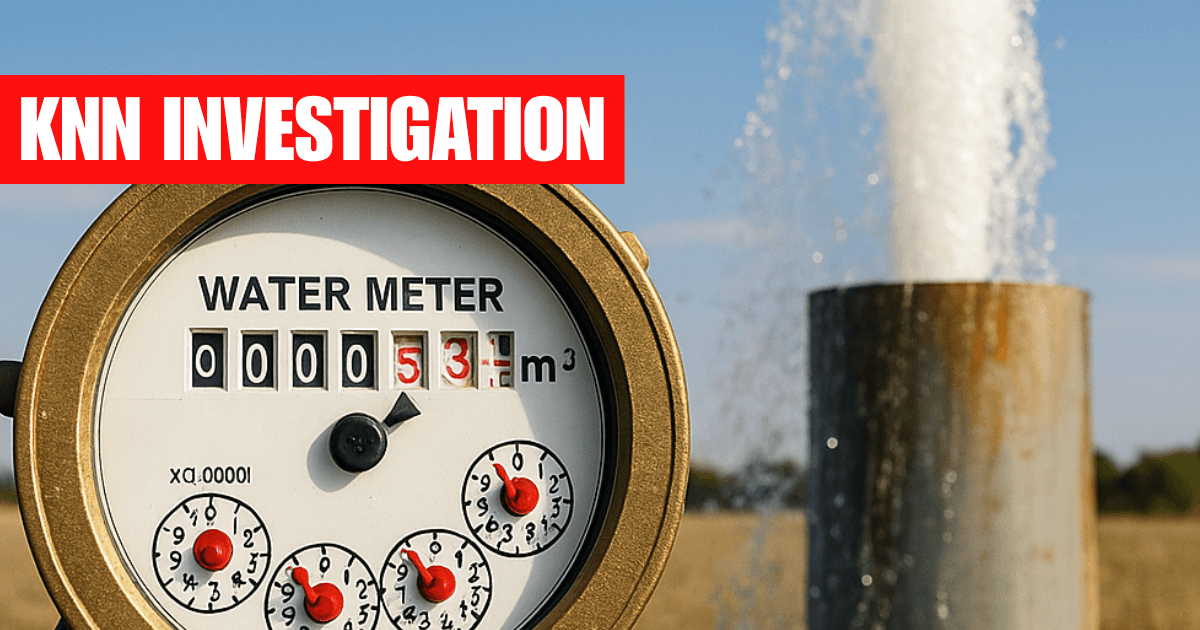In September of 2025, Hanford residents once again watched their City Council vote through a major utility project that would reshape their bills. Councilmember Mark Kairis, who made the motion, said he was willing to “bite the bullet” and added that it was time to stop “kicking the can down the road.” Mayor Travis Paden echoed the same phrase during his comments.
The record shows that the Mendes-led council of 2015 did not kick the can down the road. Instead, they approved one of the steepest water rate hikes in the city’s history, with the stated goal of paying for new wells, meters, and compliance with state mandates. In 2024, the Paden-Kairis council raised water rates again, dedicating funds to wells and meter replacements. Less than a month later, the same council raised wastewater rates by 35 percent.
From this investigation, it appears the can was never actually kicked down the road. Instead, Hanford households have been asked to carry heavier and heavier burdens through repeated rate hikes, even while leaders continue to describe the situation as if little had been done.
This report reviews the official transcripts of four key meetings, in 2015, January 2024, February 2024, and September 2025. It documents what was proposed, who voted, what residents said, and how the council justified its actions.
December 15, 2015: Resolution 15-60-R
In December of 2015, under Mayor Justin Mendes, the Hanford City Council considered a water rate hike that city staff described as necessary to secure the financial future of the system.
The proposal called for a 62 percent increase in the first year, followed by three years of 9 percent annual increases. Flat-rate customers, who had long paid set amounts regardless of consumption, would now face an additional 13.33 dollar monthly charge to fund water meter installations. The meter program was tied to state conservation mandates.
The stated uses of the money
City staff presented a detailed list of needs, far broader than just wells and meters. The additional funds would support:
Operating and Maintaining the Water System: Covering ongoing costs such as water treatment, including $240,000 to $250,000 per year for state-mandated chlorination, billing, meter reading, and energy efficiency programs. A 3 percent annual increase was included for payroll and supplies to account for inflation. This was designed to close a $780,000 yearly shortfall, driven by a $540,000 revenue loss from conservation mandates combined with rising operational costs.
Hiring and Supporting Staff: Funding state-required positions, including a regulatory compliance officer and a water conservation officer, to meet conservation and chlorination mandates. Additional maintenance workers were planned for years one and four to support system growth. These costs also included vehicles, training, and equipment maintenance.
Upgrading and Replacing Infrastructure: Addressing Hanford’s 50-year-old water system with a slate of projects:
Replacing water mains at $500,000 per year.
Upgrading a tank in the industrial park to improve fire service.
Replacing aging water meters and automated meter reading (AMR) equipment.
Installing power cell monitoring to protect against utility surges.
Setting aside $1 million per year (starting in 2017–18) to build reserves for replacing aging wells, which cost about $1.5 million each, with a target of $3 million over three years.
Meeting Debt Obligations: Ensuring compliance with bond covenants from a 2013 refinancing worth $12.7 million and a solar project lease. These covenants required revenues to exceed expenses and debt payments by 20 percent. Without compliance, bondholders could demand immediate repayment, which the city could not afford.
Building Reserves and Ensuring Compliance: Growing emergency reserves, then projected at $617,000, to respond to well failures or contamination events. Funds would also help avoid state fines of $500 per day for failing to meet conservation orders. At the time, the city had achieved an 18.5 percent reduction against a state goal of 28 percent. The plan also included preparation for the Groundwater Sustainability Act, which required balanced water usage by 2020.
The public response
The council chambers was filled, and 115 Proposition 218 protest letters were submitted. That number fell short of the threshold needed to block the increase.
Council discussion
Councilmember Russ Curry described the situation as a “perfect storm.” He explained that conservation mandates had reduced consumption, which lowered revenue, while fixed costs remained unchanged. He said that although the increase would be painful, Hanford was not alone and that agencies across California were facing similar challenges.
Councilmember Dave Ayers admitted the plan was “a huge hike” and described it as a “catch-22.” On one side, the city had to comply with conservation requirements. On the other, reduced usage meant less money for operations. He said the city had no choice if it wanted to maintain solvency.
Councilmember Gary Panett opposed the increase. He said the City Council had not done its due diligence and criticized the lack of clear communication with residents. He pointed out that increases of up to 80 percent would hit households and said, “I feel for the citizens, and I cannot vote for this knowing that they do not have the information they need.”
Councilmember Ramirez also voted no. He proposed a one-month delay so a citizens’ committee could examine the figures. He called for transparency and context, including a breakdown of how much of the revenue would go to staffing, what was tied to mandates, and how Hanford compared regionally.
The outcome
When the roll call came, Curry made the motion and Ayers seconded. The resolution passed, with Panett and Ramirez voting no.
Resolution 15-60-R took effect in January 2016, enacting one of the largest water rate hikes in Hanford’s history.
January 16, 2024: Resolution 24-02-R
Eight years later, on January 16, 2024, the council again considered water rates. This time, the numbers were tied to capital projects estimated at nearly 44 million dollars.
The proposed uses of the money
Wells: Continued investment in the city’s well system.
Water Meter Replacements: Consultants reported that Hanford had about 18,000 meters, with more than 17,000 in the smallest residential size. Many of these meters were nearing the end of their useful lives. The cost of replacement was estimated at 15 to 20 million dollars.
New Well and Tank at Heroes Park: A specific project included in the plan.
Council action
When the vote came, Councilmember Sharp made the motion and Vice Mayor Mark Kairis seconded. The measure passed 4 to 1.
Mayor Travis Paden and Councilmember Lou Martinez voted in favor. Resolution 24-02-R took effect on February 1, 2024.
February 6, 2024: Resolution 24-03-03-R
Less than a month later, wastewater rates came before the council.
The proposal
Staff said that while daily operations were funded, reserves and debt obligations were underfunded. The proposal called for a 35 percent increase effective March 1, 2024, followed by annual hikes each July. A typical household’s wastewater bill would rise from about 18 to 25 dollars per month.
Resident comments
Rusty Brookshire urged the council to phase in the increase more slowly.
Anna Brookshire criticized the city for a lack of transparency in how the plan was presented.
Council action
When the vote came, Vice Mayor Mark Kairis made the motion and Councilmember Sharp seconded. The measure passed unanimously, 5-0, with Mayor Paden and Councilmember Martinez also in support.
Resolution 24-03-03-R took effect on March 1, 2024.
By the end of February, Hanford residents had been hit with two significant utility hikes in less than a month.
September 16, 2025: Wastewater Modernization and Solar Project
On September 16, 2025, the council considered a 63 million dollar wastewater modernization and solar project.
The proposal
New Oxidation Ditch and New Clarifiers.
Decommissioning of Older Systems.
Solar Facilities projected to save 122 million dollars over 35 years.
Consultants reported the wastewater plant, last expanded in 2001, was already at 85 percent capacity and would reach full capacity within five to six years.
Resident comments
One resident said her household bill had already risen from 75 to 135 dollars since 2024.
Another questioned whether the projected savings from the solar project would actually materialize.
Council discussion
Councilmember Mark Kairis said: “I will bite the bullet. I will make a motion to not keep kicking the can down the road. It is a bitter pill to swallow, but we have to move forward.”
Mayor Travis Paden repeated the phrase, saying the city could not keep “kicking the can down the road.”
The outcome
The measure passed unanimously, 5-0.
A Decade of Decisions
The record from 2015 through 2025 shows a consistent pattern of steep rate hikes, clear purposes, and repeated objections.
2015: Curry called the problem a “perfect storm.” Ayers admitted it was “a huge hike” and a “catch-22.” Panett said the council had not done its due diligence. Ramirez asked for a one-month delay. Motion by Curry, seconded by Ayers. Passed, with Panett and Ramirez voting no.
2024 January: Nearly 44 million in water projects, including meters and wells. Motion by Sharp, seconded by Kairis. Passed 4-1, with Paden and Martinez in support.
2024 February: Wastewater increase of 35 percent. Rusty Brookshire asked for a slower phase-in. Anna Brookshire criticized transparency. Motion by Kairis, seconded by Sharp. Passed 5-0, with Paden and Martinez in support.
2025 September: 63 million wastewater modernization. A resident reported bills had risen by 60 dollars since 2024. Another questioned projected savings. Kairis made the motion and warned against “kicking the can down the road.” Paden echoed the phrase. Passed 5-0.
Conclusion: The Can Was Never Kicked
The official transcripts show that Hanford’s utility rate history from 2015 to 2025 has been marked by repeated hikes justified by similar arguments. Each council said the hikes were necessary. Each time, residents voiced opposition. Each time, the measures passed.
In 2015, Councilmembers Panett and Ramirez said the city had not done its due diligence and pressed for more transparency. In 2024, residents Rusty and Anna Brookshire said the same. In 2025, Kairis and Paden told residents the city could no longer keep kicking the can down the road.
From this investigation, it appears the can was never actually kicked down the road. The Mendes-led council of 2015 raised rates and committed money to wells, meters, and compliance. The Paden-Kairis council of 2024 raised rates again for wells, meters, and wastewater. In 2025, those same leaders claimed to be ending years of delay, even though multiple increases had already been enacted.
Until Hanford can demonstrate that the repeated promises have been delivered in the form of new wells, replaced meters, and a modern wastewater facility, residents will continue to ask the same question: have things really changed, or are they simply paying more without seeing the results?
Watch the Hearings Yourself
Judge for yourself. Below are the four City Council public hearings where water and wastewater rates were debated and approved. These are the official records of what was said, who made the motions, and how each vote was cast. Do not just take my word for it. Watch the videos in full and see exactly how these decisions were made.
Hanford City Council Approves Major Water Rate Hike (December 15, 2015)
Hanford Council Approves $44 Million Water Projects (January 16, 2024)
Hanford Council Votes 35% Wastewater Rate Increase (February 6, 2024)
Hanford Council Approves $63 Million Wastewater Modernization (September 16, 2025)








